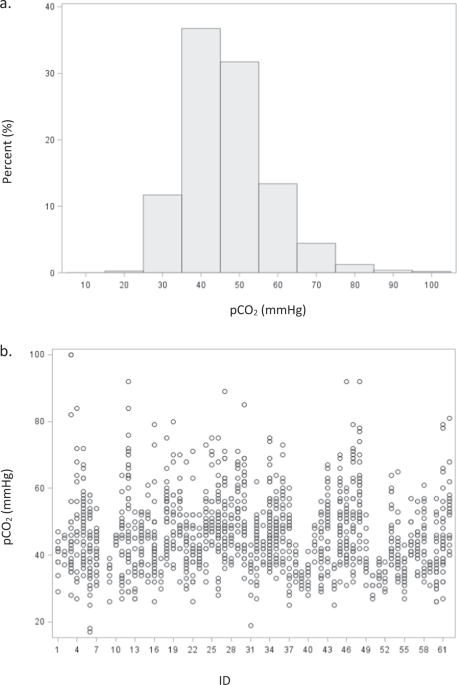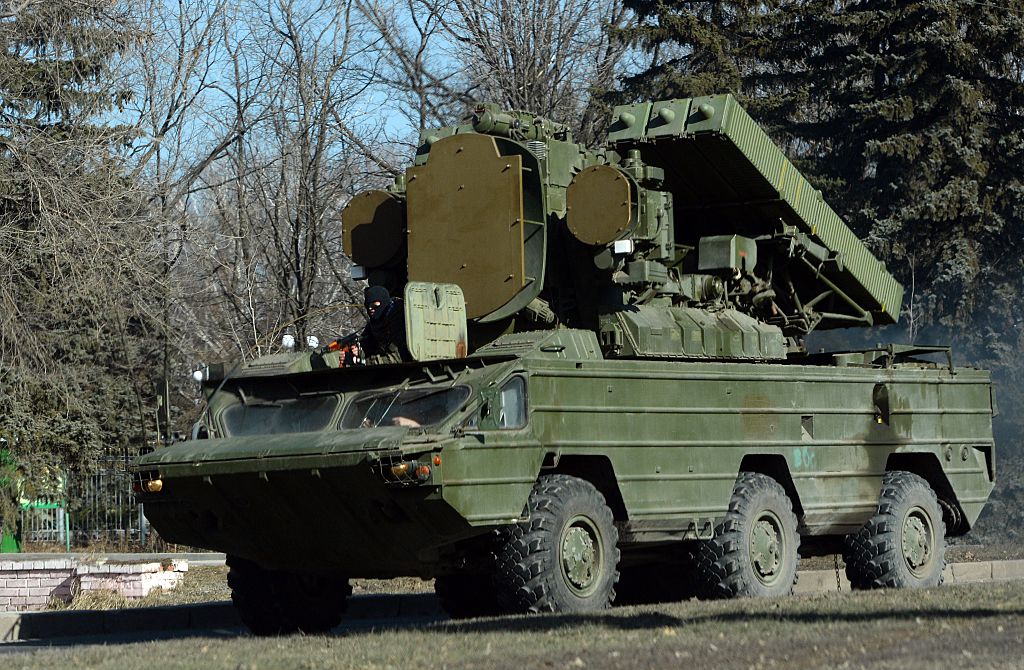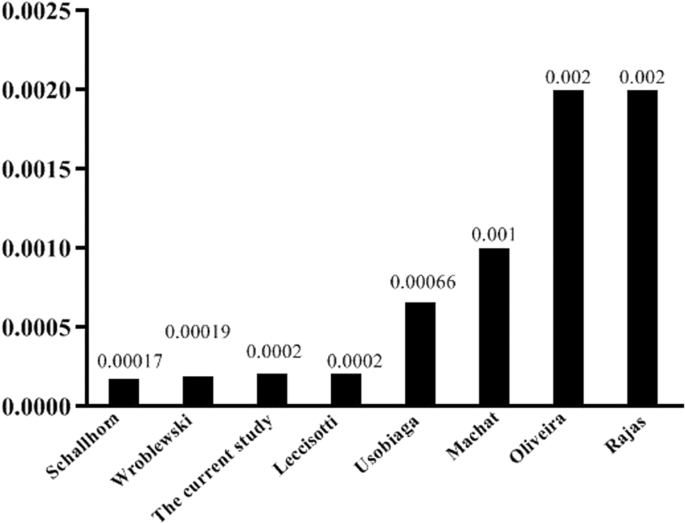
- Select a language for the TTS:
- UK English Female
- UK English Male
- US English Female
- US English Male
- Australian Female
- Australian Male
- Language selected: (auto detect) - EN
Play all audios:
ABSTRACT OBJECTIVE Evaluate the association between carbon dioxide (pCO2), cerebral blood flow (CBF), and cerebral autoregulation (CA) in preterm infants. STUDY DESIGN Cerebral saturations
(rScO2, surrogate for CBF using NIRS) and mean arterial blood pressure (MAP) monitored for 96 h in infants <29 weeks gestation. Relationship between rScO2, the rScO2-MAP correlation (CA
analysis) and pCO2 category assessed by mixed effects modeling. RESULTS Median pCO2 differed by postnatal day (_p_ < 0.0001)—pCO2 increased between day 1 and 2, and low variability seen
on day 4. A 5% increase in rScO2 was noted when pCO2 was >55 mmHg on each postnatal day (_p_ < 0.001). No association observed between the overall rScO2-MAP correlation and pCO2. On
day 1 only, the correlation coefficient decreased from 0.26 to −0.09 as pCO2 category increased (_p_ = 0.02). CONCLUSIONS CBF increased above a pCO2 threshold of 55 mmHg, but overall, no
association between pCO2 and CA was noted. Access through your institution Buy or subscribe This is a preview of subscription content, access via your institution ACCESS OPTIONS Access
through your institution Subscribe to this journal Receive 12 print issues and online access $259.00 per year only $21.58 per issue Learn more Buy this article * Purchase on SpringerLink *
Instant access to full article PDF Buy now Prices may be subject to local taxes which are calculated during checkout ADDITIONAL ACCESS OPTIONS: * Log in * Learn about institutional
subscriptions * Read our FAQs * Contact customer support SIMILAR CONTENT BEING VIEWED BY OTHERS CEREBRAL OXYGEN SATURATION AND AUTOREGULATION DURING HYPOTENSION IN EXTREMELY PRETERM INFANTS
Article 20 April 2021 ASSOCIATION BETWEEN EARLY CEREBRAL OXYGENATION AND NEURODEVELOPMENTAL IMPAIRMENT OR DEATH IN PREMATURE INFANTS Article 15 February 2021 LONGITUDINAL PILOT STUDY OF
OXYGEN SATURATION INDICES IN HEALTHY PRETERM INFANTS Article Open access 04 August 2023 REFERENCES * Jayasinghe D, Gill AB, Levene MI. CBF reactivity in hypotensive and normotensive preterm
infants. Pediatr Res. 2003;54:848–53. http://www.ncbi.nlm.nih.gov/pubmed/12904589. Article Google Scholar * Noori S, Anderson M, Soleymani S, Seri I. Effect of carbon dioxide on cerebral
blood flow velocity in preterm infants during postnatal transition. Acta Paediatr. 2014;103:e334–9. http://www.ncbi.nlm.nih.gov/pubmed/24673183. Article CAS Google Scholar * Pryds O,
Greisen G, Skov LL, Friis-Hansen B. Carbon dioxide-related changes in cerebral blood volume and cerebral blood flow in mechanically ventilated preterm neonates: comparison of near infrared
spectrophotometry and 133Xenon clearance. Pediatr Res. 1990;27:445–9. http://www.ncbi.nlm.nih.gov/pubmed/2161099. Article CAS Google Scholar * Hoffman SB, Cheng YJ, Magder LS, Shet N,
Viscardi RM. Cerebral autoregulation in premature infants during the first 96 h of life and relationship to adverse outcomes. Arch Dis Child Fetal Neonatal Ed. 2018.
http://www.ncbi.nlm.nih.gov/pubmed/30385514. * Soul JS, Hammer PE, Tsuji M, et al. Fluctuating pressure-passivity is common in the cerebral circulation of sick premature infants. Pediatr
Res. 2007;61:467–73. http://www.ncbi.nlm.nih.gov/pubmed/17515873. Article Google Scholar * Alderliesten T, Lemmers PM, Smarius JJ, van de Vosse RE, Baerts W, van Bel F. Cerebral
oxygenation, extraction, and autoregulation in very preterm infants who develop peri-intraventricular hemorrhage. J Pediatr. 2012. http://www.ncbi.nlm.nih.gov/pubmed/23140883. * O’Leary H,
Gregas MC, Limperopoulos C, et al. Elevated cerebral pressure passivity is associated with prematurity-related intracranial hemorrhage. Pediatrics. 2009;124:302–9.
http://www.ncbi.nlm.nih.gov/pubmed/19564313. Article Google Scholar * Tsuji M, Saul JP, du Plessis A, et al. Cerebral intravascular oxygenation correlates with mean arterial pressure in
critically ill premature infants. Pediatrics. 2000;106:625–32. http://www.ncbi.nlm.nih.gov/pubmed/11015501. Article CAS Google Scholar * Gilmore MM, Stone BS, Shepard JA, Czosnyka M,
Easley RB, Brady KM. Relationship between cerebrovascular dysautoregulation and arterial blood pressure in the premature infant. J Perinatol. 2011;31:722–9.
http://www.ncbi.nlm.nih.gov/pubmed/21372795. Article CAS Google Scholar * Brady KM, Lee JK, Kibler KK, et al. Continuous time-domain analysis of cerebrovascular autoregulation using
near-infrared spectroscopy. Stroke. 2007;38:2818–25. http://www.ncbi.nlm.nih.gov/pubmed/17761921. Article Google Scholar * Kaiser JR, Gauss CH, Williams DK. The effects of hypercapnia on
cerebral autoregulation in ventilated very low birth weight infants. Pediatr Res. 2005;58:931–5. http://www.ncbi.nlm.nih.gov/pubmed/16257928. Article Google Scholar * Vesoulis ZA, Mathur
AM. Cerebral autoregulation, brain injury, and the transitioning premature infant. Front Pediatr. 2017;5:64. http://www.ncbi.nlm.nih.gov/pubmed/28421173. Article Google Scholar * Levene
MI, Fawer CL, Lamont RF. Risk factors in the development of intraventricular haemorrhage in the preterm neonate. Arch Dis Child. 1982;57:410–7. http://www.ncbi.nlm.nih.gov/pubmed/7092304.
Article CAS Google Scholar * Dolfin T, Skidmore MB, Fong KW, Hoskins EM, Shennan AT. Incidence, severity, and timing of subependymal and intraventricular hemorrhages in preterm infants
born in a perinatal unit as detected by serial real-time ultrasound. Pediatrics. 1983;71:541–6. http://www.ncbi.nlm.nih.gov/pubmed/6835737. CAS PubMed Google Scholar * Ballabh P.
Intraventricular hemorrhage in premature infants: mechanism of disease. Pediatr Res. 2010;67:1–8. http://www.ncbi.nlm.nih.gov/pubmed/19816235. Article Google Scholar * Thome UH,
Ambalavanan N. Permissive hypercapnia to decrease lung injury in ventilated preterm neonates. Semin Fetal Neonatal Med. 2009;14:21–7. https://doi.org/10.1016/j.siny.2008.08.005. Article
PubMed Google Scholar * Carlo WA, Stark AR, Wright LL, et al. Minimal ventilation to prevent bronchopulmonary dysplasia in extremely-low-birth-weight infants. J Pediatr. 2002;141:370–5.
Article Google Scholar * Mariani G, Cifuentes J, Carlo WA. Randomized trial of permissive hypercapnia in preterm infants. Pediatrics. 1999;104:1082–8. Article CAS Google Scholar * Ryu
J, Haddad G, Carlo WA. Clinical effectiveness and safety of permissive hypercapnia. Clin Perinatol. 2012;39:603–12. Article Google Scholar * Jeong SM, Kim SO, DeLorey DS, Babb TG, Levine
BD, Zhang R. Lack of correlation between cerebral vasomotor reactivity and dynamic cerebral autoregulation during stepwise increases in inspired CO2 concentration. J Appl Physiol.
2016;120:1434–41. http://www.ncbi.nlm.nih.gov/pubmed/27103653. Article CAS Google Scholar * Ainslie PN, Duffin J. Integration of cerebrovascular CO2 reactivity and chemoreflex control of
breathing: mechanisms of regulation, measurement, and interpretation. Am J Physiol Regul Integr Comp Physiol. 2009;296:R1473–95. http://www.ncbi.nlm.nih.gov/pubmed/19211719. Article CAS
Google Scholar * Paulson OB, Strandgaard S, Edvinsson L. Cerebral autoregulation. Cerebrovasc Brain Metab Rev. 1990;2:161–92. http://www.ncbi.nlm.nih.gov/pubmed/2201348. CAS PubMed Google
Scholar * Zhang R, Zuckerman JH, Giller CA, Levine BD. Transfer function analysis of dynamic cerebral autoregulation in humans. Am J Physiol. 1998;274:H233–41.
http://www.ncbi.nlm.nih.gov/pubmed/9458872. CAS PubMed Google Scholar * Meng L, Gelb AW. Regulation of cerebral autoregulation by carbon dioxide. Anesthesiology. 2015;122:196–205.
http://www.ncbi.nlm.nih.gov/pubmed/25401418. Article Google Scholar * Dix LML, Weeke LC, de Vries LS, et al. Carbon dioxide fluctuations are associated with changes in cerebral oxygenation
and electrical activity in infants born preterm. J Pediatr. 2017;187:66–72 e1. http://www.ncbi.nlm.nih.gov/pubmed/28578157. Article Google Scholar * Greisen G, Vannucci RC. Is
periventricular leucomalacia a result of hypoxic-ischaemic injury? Hypocapnia and the preterm brain. Biol Neonate. 2001;79:194–200. http://www.ncbi.nlm.nih.gov/pubmed/11275650. Article CAS
Google Scholar * Sidorenko I, Turova V, Botkin N, et al. Modeling cerebral blood flow dependence on carbon dioxide and mean arterial blood pressure in the immature brain with accounting
for the germinal matrix. Front Neurol. 2018;9:812. http://www.ncbi.nlm.nih.gov/pubmed/30356709. Article Google Scholar Download references FUNDING This study is funded by the Mentored
Population and Clinical Research Program of the American Heart Association, Award #14CRP18140003 to SBH. AUTHOR INFORMATION AUTHORS AND AFFILIATIONS * Department of Pediatrics, University of
Maryland Baltimore, School of Medicine, Baltimore, MD, USA Suma Bhat Hoffman, Anisa Lakhani & Rose Marie Viscardi Authors * Suma Bhat Hoffman View author publications You can also
search for this author inPubMed Google Scholar * Anisa Lakhani View author publications You can also search for this author inPubMed Google Scholar * Rose Marie Viscardi View author
publications You can also search for this author inPubMed Google Scholar CORRESPONDING AUTHOR Correspondence to Suma Bhat Hoffman. ETHICS DECLARATIONS CONFLICT OF INTEREST The authors
declare that they have no conflict of interest. ADDITIONAL INFORMATION PUBLISHER’S NOTE Springer Nature remains neutral with regard to jurisdictional claims in published maps and
institutional affiliations. RIGHTS AND PERMISSIONS Reprints and permissions ABOUT THIS ARTICLE CITE THIS ARTICLE Hoffman, S.B., Lakhani, A. & Viscardi, R.M. The association between
carbon dioxide, cerebral blood flow, and autoregulation in the premature infant. _J Perinatol_ 41, 324–329 (2021). https://doi.org/10.1038/s41372-020-00835-4 Download citation * Received: 06
April 2020 * Revised: 24 August 2020 * Accepted: 18 September 2020 * Published: 08 October 2020 * Issue Date: February 2021 * DOI: https://doi.org/10.1038/s41372-020-00835-4 SHARE THIS
ARTICLE Anyone you share the following link with will be able to read this content: Get shareable link Sorry, a shareable link is not currently available for this article. Copy to clipboard
Provided by the Springer Nature SharedIt content-sharing initiative






